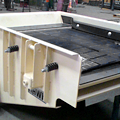THE VERSATILITY OF BRUTE FORCE VIBRATING PAN FEEDERS
July 15, 2015
Vibratory feeders are a suspended or floor-mounted inclined welded steel frame that aids in transporting, supplying, and maintaining a flow of materials, such as rock, sand, and aggregates, demo debris, asphalt, and concrete, and others, at a constant rate, to the crusher or extractor from hoppers or surge piles, to be separated or crushed.
Brute force feeders (also known as vibrating grizzly feeders or VGFs in some locations) are subjected to continual load impact. Their adjustable contra-rotating twin electric motor drives ensure a consistent linear motion. This linear vibrating method is used for feeding, screening, conveying, sorting, grading, packing and setting, and can also be achieved using dual rotating rotary vibrators, piston vibrators, or crank arms. The material is rapidly moved back and forth and then thrown up and forward as the pan moves back. This is also referred to as the feeder’s amplitude. The times per minute this process is repeated is the frequency. How high the material is thrown, compared to its horizontal movement is the angle of deflection.
Brute force vibratory feeders are typically inclined at 50 to 120 and utilize offset weight vibrators to feed dry materials downstream along a pan into crushing or extraction equipment. Sticky, friable, or easily-smeared materials are best suited to this type of operation.
Vibrating pans, trays, or troughs are constructed from general-purpose mild steel with stainless or abrasion-resistant steel, polyethylene, epoxy, or other liner coating. Pan shape may be tubular, v-channeled, or flat, and as long as deemed appropriate.
BRUTE FORCE MOTOR VERSATILITY
Brute force vibratory feeders are operated by simple mechanical drives. These drives produce the tray’s back and forth motion via a push rod or by out-of-balance weights. The tray vibration is increased through a set of springs. Large motors are required to overcome the weight of material, or head load, sitting in the tray.
Brute force vibratory feeders are typically operated using two contra-rotating electric motor drives that have eccentric weights on each end of a shaft. These weights create an “out-of-balance vibration and motion” into the tray.
Brute force electric motors have variable speeds and adjustable degree counterweights to change force outputs. Frequencies can vary from 900RPM and 1200RPM to 1800RPM and 3600RPM to provide continuous operation.
Brute force vibratory feeders may also be operated by reciprocating air piston vibrators that create the required force for lower feed rates. These type of vibrators are air-purged and reduce any possibility of explosions. They may also be hosed during operation. Motor dimensions range from 450mm x 800mm to 2200mm x 2200mm and operate between 0.20 KW and 11.00 KW.
Low horsepower increases efficiency. Explosion-proofed electric air-purged motors handle chemical, explosive, and hazardous materials. The frame can also deliver screening media for light as well as coarse materials.
Screening Technology Pty Ltd T/AS Hawk Machinery
Address: 7 Lantana St Blackburn North Vic 3130
Contact Person: Bohdan Blaszczyk
Phone: +61 3 9877 7777
Fax: +61 3 9877 8177
Mobile: 0411 099 989
Email: info@hawkmachinery.com.au
Optimized by NetwizardSEO.com.au
Optimized by: Netwizard SEO


